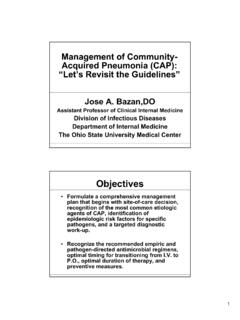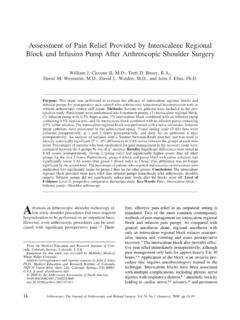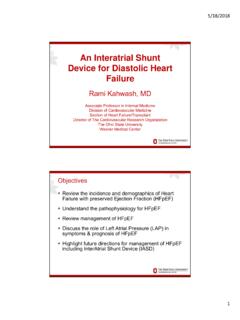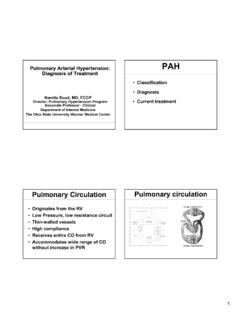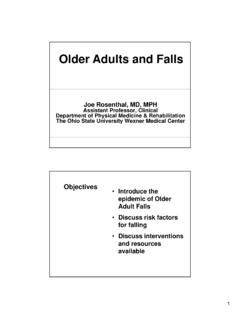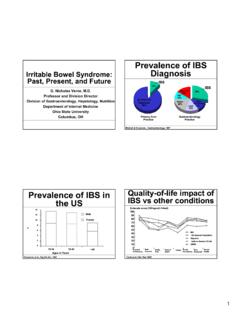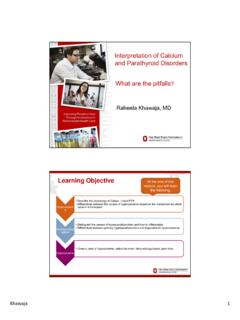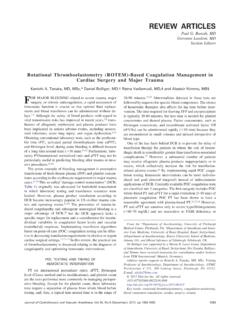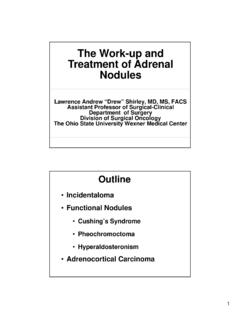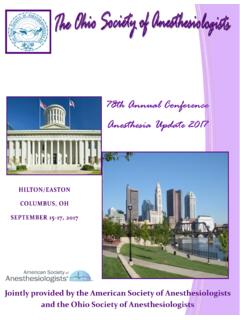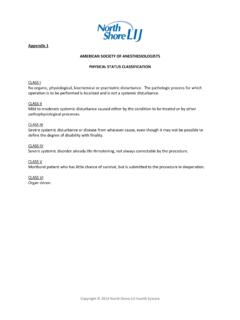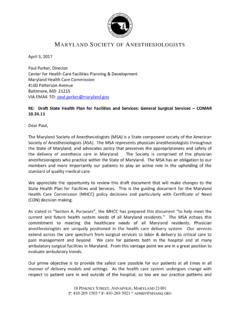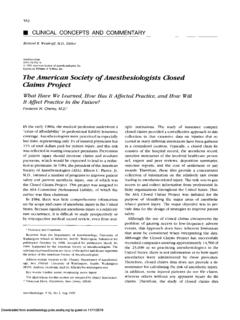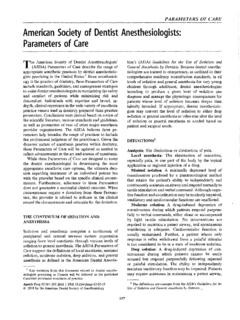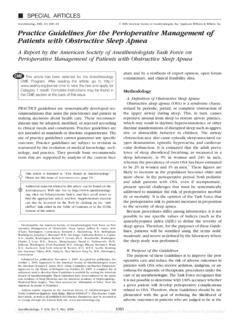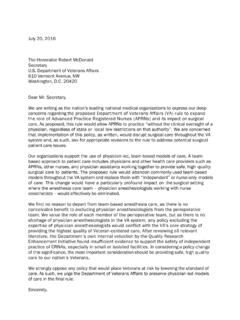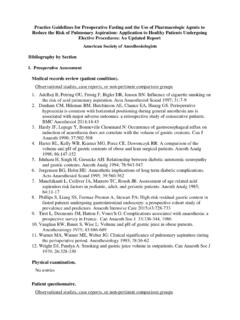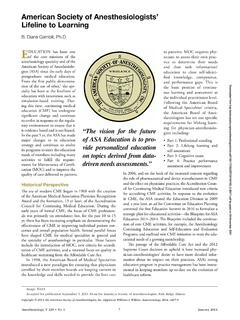Transcription of The Heart Rhythm Society (HRS)/American Society of ...
1 The Heart Rhythm Society (HRS)/ american Society ofAnesthesiologists (ASA) Expert Consensus Statement on thePerioperative Management of Patients with ImplantableDefibrillators, Pacemakers and Arrhythmia Monitors: Facilitiesand Patient Management: Executive SummaryThis document was developed as a joint project with the american Society of Anesthesiologists(ASA), and in collaboration with the american Heart Association (AHA), and the Society ofThoracic Surgeons (STS)George H. Crossley, MD, FHRS,1 Jeanne E. Poole, MD, FHRS,2 Marc A. Rozner, PhD, MD,3*Samuel J. Asirvatham, MD, FHRS,4 Alan Cheng, MD,5!Mina K. Chung, MD, FHRS,6T. Bruce Ferguson, Jr., MD,7##John D. Gallagher, MD,8* Michael R. Gold, MD, PhD, FHRS,9#Robert H. Hoyt, MD,10 Samuel Irefin, MD,11* Fred M. Kusumoto, MD, FHRS,12 Liza Prudente Moorman, MSN, ACNP, FHRS,13 Annemarie Thompson, MD14*From1St. Thomas Research Institute and University of Tennessee College of Medicine, Nashville, Tennessee,2 University ofWashington, Seattle, Washington,3 University of Texas, Department of Anesthesiology and Perioperative Medicine, Houston,Texas,4 Mayo Clinic, Rochester, Minnesota,5 Johns Hopkins University School of Medicine, Baltimore, Maryland,6 ClevelandClinic, Department of CV Medicine, Cleveland, Ohio,7 East Carolina Heart Institute, Department of Cardiovascular Sciences,Greenville, North Carolina,8 Dartmouth Medical School, Hanover, New Hampshire,9 Medical University of South Carolina,Charleston, South Carolina,10 Iowa Heart Center, West Des Moines, Iowa,11 Cleveland Clinic, Department of Anesthesiology,Cleveland, Ohio,12 Mayo Clinic, Jacksonville, Florida,13 University of Virginia Health Systems, Charlottesville, Virginia, and14 Vanderbilt University Department of Anesthesiology, Nashville, Tennessee.
2 *Representing the american Society of Anesthesiologists.#Representing the american College of Cardiology Foundation.!Representing the american Heart Association.##Representing the Society of Thoracic purpose of this document is to provide an expertconsensus on the management of patients with cardiovas-cular implantable electronic devices (CIEDs) during andafter surgical or medical procedures. This writing group,appointed by the Heart Rhythm Society (HRS) and theAmerican Society of Anesthesiologists (ASA), is a rep-resentative group of experts in pacemaker and defibril-lator management. Each of the authors is an expert in themanagement of CIEDs in the setting of medical proce-dures that might interfere with their function. The writingand reference groups are described in the main statement represents the consensus of the writingcommittee. In generating its consensus, the committeereviewed a large body of literature, which consistsmainly of case reports and small series of cases.
3 Thereare no randomized controlled trials and very few caseseries to rely upon; therefore, many of the recommenda-tions are based upon the extensive experience of theABBREVIATIONS ASA! american Society of Anesthesiologists;ATP!antitachycardia pacing;CIED!cardiovascular implantableelectronic device;CIED team!the physician, nurse, and technicianswho care for the patient s CIED;CRT-D!cardiac resynchronizationtherapy defibrillator;CT!computed tomography;ECT!electrocon-vulsive therapy;EOL!end of life;ERI!elective replacement indica-tor;EMG!electromyography;EMI!elec tromagnetic interference;GI!gastrointestinal;HRS!Hea rt Rhythm Society ;ICD!implant-able cardioverter-defibrillator;IEAP!industry -employed allied pro-fessional;ILR!implantable loop recorder;J!joule;LV!left ven-tricle;perioperative team!the anesthesiologist , surgeon, and/or otherphysicians and nurses associated with the procedure and the preparationfor that procedure;PM!pacemaker;RF!radiofrequency ;RFID!
4 Ra-dio frequency identification;TENS!transcutaneous electrical nervestimulation;TUNA!transurethral needle ablation;TURP!transure-thral resection of the prostate( Heart Rhythm 2011;8:e1 e18)Endorsed by the Heart Rhythm Society , the american College ofCardiology Foundation and the american Heart requests and correspondence:Sonja Olson, Heart Rhythm So-ciety, 1400K Street, NW, suite 500, Washington DC 20005. -see front matter 2011 Published by Elsevier Inc. on behalf of Heart Rhythm group. Consequently, there has been no assign-ment of levels of evidence. The consensus document isintended to provide guidance to health care professionalswho care for patients with CIEDs. It is especially in-tended to give CIED professionals guidance in the pro-vision of an appropriate prescription for the perioperativecare of patients with CIEDs. In preparing this ExecutiveSummary, we have emphasized those aspects we believebest reflect the overall intent and content of the document:The document represents the con-sensus of the writing committee, which was developed asdescribed above.
5 In writing a consensus document, it isrecognized that consensus does not mean that there wascomplete agreement among all writing group members. Theexpert panel identified those aspects of perioperative man-agement of CIEDs for which a true consensus could beachieved. Surveys of the entire writing group were used toidentify these areas of consensus. For the purposes of thisdocument they defined a consensus as 85% or greater agree-ment by the authors of this use of the consensus document:When usingor considering the guidance given in this document, it isimportant to remember that there are no absolutes withregard to many clinical situations. The ultimate judgmentregarding care of a particular patient must be made by thehealth care provider and patient in light of all the circum-stances presented by that patient, the management optionsavailable, as well as the relative risks and benefits. Thisdocument focuses on the management of patients withCIEDs who are undergoing medical procedures.
6 The writ-ing committee focused specifically on perioperative man-agement of the CIED and explicitly excluded issues con-cerning magnet resonance imaging because of the evolvingtechnology in that area. Further, they did not address thewider arena of the assessment of the perioperative clinicalrisk of these patients, many of whom have medical condi-tions that remarkably increase their surgical risk. Certaindetails have been removed from this executive recommend reading the entire article for a comprehen-sive perioperative period poses unique challenges to assure ahigh degree of patient safety for patients with pacemakers anddefibrillators. The potential problems that can occur in patientswith a CIED in the perioperative setting are detailed. Weprovide recommendations for the appropriate preoperativeevaluation, intraoperative management and postoperative careof the patient with a CIED undergoing medical 1displays our general areas of strongly believe that the best perioperative care of apatient with a CIED will result from the CIED team providingaspecificprescriptionforCIED managementtotheproceduralteam.
7 Information regarding the nature of the planned proce-dure and potential risks for the patient with a CIED must beshared with the CIED team in order for this prescription to beformed. It is our strong consensus that physicians withoutexperience in CIED management will have a difficult timenavigating through the morass of technological differences andrecommendations. Therefore, we strongly recommend that thepatient s own CIED team (or another available CIED team)give the operative team recommendations for the perioperativemanagement of the patients will not need ade novopreoperative eval-uation by the CIED management team as generally therequired information resides in the records of the CIED clinic. If this information is not accessible, the next bestapproach is to have an available CIED team evaluate thatpatient and provide a recommendation and the necessarycommunication to the operative team. However, it is notappropriate for the perioperative evaluation and prescriptionto be determined and delivered by an industry-employedallied professional (IEAP).
8 1We strongly support the priorHRS recommendations that representative members of theCIED manufacturers cannot be placed in a position of med-ical responsibility to provide independent prescriptive rec-ommendations or independent post-operative CIED is well beyond their scope of is not tosay that an IEAP cannot assist with the technical part of thatevaluation as long as the IEAP is under the supervision of aphysician experienced in CIED unique to the CIED patient andelectromagnetic interference risk duringsurgical or medical proceduresElectromagnetic interferenceEMI causing malfunction of pacemakers and defibrillatorsis well-described2and is the most common problem occur-ring in patients with CIEDs. The perioperative period isparticularly problematic as patients are exposed to a numberTable 1 General principles of CIED management The perioperative management of CIEDs must beindividualized to the patient, the type of CIED and theprocedure being performed.
9 A single recommendation for allCIED patients is not appropriate A CIED team is defined as the physicians and physicianextenders who monitor the CIED function of the patient The surgical or procedural team should communicate with theCIED team to identify the type of procedure and likely risk ofEMI The CIED team should communicate with the procedure teamto deliver a prescription for the perioperative management ofpatients with CIEDs For most patients, the prescription can be made from areview of the records of the CIED clinic. A small percentageof patients may require consultation from CIED specialists ifthe information is not available It is inappropriate to have industry-employed allied healthprofessionals independently develop this prescriptione2 Heart Rhythm , Vol 8, No 7, July 2011of energy sources and machinery that may generate EMIand interact with a CIED, ranging from transient effectssuch as pacing inhibition, inappropriate tracking of electri-cal noise, damage at the lead tissue interface, pulse gener-ator damage, and the induction of an electrical reset can also interfere with rate responsive algorithms andcan rarely cause pulse generator damage.
10 The clinical im-pact of EMI on the patient depends upon clinical indicationsfor their CIED, the patient s intrinsic rate and Rhythm , thepacing mode, as well as the functioning of protective cir-cuitry engineered to filter out extraneous electrical currents,and manufacturer-specific algorithms designed to minimizeadverse clinical most common source of EMI is electrosurgical en-ergy. The problems seen with electrocautery are summa-rized inTable 2. Other sources of EMI are listed inAppen-dix 2and will not be discussed in this summary. The readeris referred to the main Consensus energyElectrosurgery involves the application of focused radiofrequency electrical current to produce tissue desiccation,cutting or coagulation. Electrical current can be delivered inbipolar or monopolar configurations, and with a variety ofpower waveforms to produce these tissue effects. For bipo-lar electrosurgery ( , ophthalmic and microsurgery) thereappears to be minimal chance for an adverse CIED ,4In monopolar electrosurgery, electrical current isapplied via a small active electrode pen or stylus to theoperative site, and then flows through the patient s body toa large surface area return electrode.
